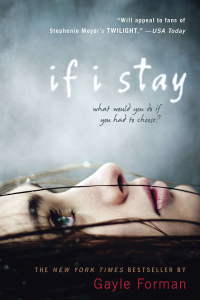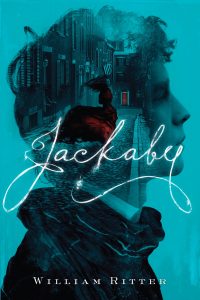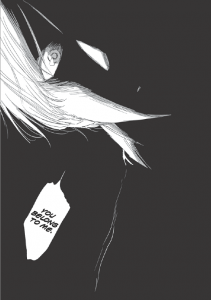 If I Stay
If I Stay
Mia has a perfect family (hip parents, adorable younger brother) and a perfect boyfriend (Adam, a sensitive punk rocker) and is a perfect cellist (surpasses multiple teachers!) whose perfect audition landed her a spot at Juilliard after graduation. Her perfect life (well, okay, there’s a modicum of tension with Adam about her moving away to New York in the fall) is destroyed when a car accident on a snowy day claims the lives of her parents and brother and leaves Mia in a state of astral projection, able to see what’s happening to her body while she struggles to decide whether to stay and live out her life after such a devastating loss or die and potentially join her family.
I’m not sure what I expected from If I Stay, exactly. Perhaps something spookier? Instead, it mostly alternates between Mia reflecting on memories with various loved ones and observing the goings-on at the hospital, including an episode in which Adam, instead of simply asking Mia’s grandparents to help him get in to see her, stages an elaborate distraction involving a rock star singing in the corridor outside the ICU. It’s as cringey as it sounds. I also wasn’t fond of the suggestion that it’s inherently virtuous to like classical music.
Despite my complaints, though, I didn’t hate it. Mia’s “this can’t be real” terror is conveyed well and I did get unexpectedly verklempt a couple of times. The book also gets much better once Mia’s best friend, Kim, is introduced. It’s through stories about Kim that we finally start to see Mia as someone less than perfect, which is decidedly welcome. I do find, though, that I wish the whole book had been about Kim in the first place! I find her much more interesting than Mia.
In any case, I did like this enough to check out the sequel.
 Where She Went
Where She Went
Where She Went is quite a lot better than its predecessor. Told from Adam’s perspective, it’s set three years in the future as he—now a world-famous, Grammy-winning rock star and yet totally miserable—runs into Mia in New York City. It turns out Mia dumped Adam only a few weeks after she went off to Juilliard and never told him why, which completely destroyed him for a while until he channeled his pain into a batch of songs that would catapult Shooting Star’s major-label debut into multi-platinum status. They each have one night before they’re due to head out on tour and Mia suggests they spend it checking out some of her favorite spots around the city.
I thought Adam’s mental state was conveyed well. He’s hurt, he’s angry, he’s closed off, he’s sick of being tabloid fodder, and he no longer feels any love for music. Although he once vowed to let Mia go if she would just stay, it’s clear that he hasn’t been able to do that. Throughout the course of their conversation, however, he’s finally able to see that the person who’s really been harming him all this time is him, not Mia. The payoff here felt well-earned. Also, Mia does not come off as perfect here as she did in the first installment, which I appreciated.
In a series with some supernatural touches around the edges, it’s notable that the thing that really stretched my credulity is that everyone is so ridiculously successful at such a young age. Adam is a huge celebrity. Mia was extra special even at Juilliard and their meeting occurred at a concert she was giving at Carnegie Hall. Not only that, she’s somehow famous enough that a journalist from the rock scene knows about her and wants the scoop on her and Adam’s relationship. Even Kim has become a war photographer who sells her photos to The New York Times.
Still, this was quite good and made me a bit sniffly, which I perversely enjoy.

 Jackaby
Jackaby “The Map”
“The Map” Beastly Bones
Beastly Bones Ghostly Echoes
Ghostly Echoes The Dire King
The Dire King





 I’d heard good things about The Ancient Magus’ Bride from my Manga Bookshelf compatriots, but I had also heard about a sad fate befalling some cats, so I steered clear. After reading and really enjoying Kore Yamazaki’s
I’d heard good things about The Ancient Magus’ Bride from my Manga Bookshelf compatriots, but I had also heard about a sad fate befalling some cats, so I steered clear. After reading and really enjoying Kore Yamazaki’s  She’s purchased by a mage named Elias Ainsworth, who takes her as his apprentice. Elias is not entirely human and not entirely fae, either. Most of the time he assumes the form of a tall human with a head somewhat like a cow’s skull, but his real form is something far stranger. Despite his scary looks, he’s kind to Chise, insisting that she be neither passive nor servile, and she’s soon comfortable in his home in the countryside west of London. Eventually, he tells her that because of her ability to absorb and generate mass quantities of magic, her lifespan is destined to be brief. Part of the reason he bought her was to try to help overcome this while also learning more about humans. And to be his bride, of course.
She’s purchased by a mage named Elias Ainsworth, who takes her as his apprentice. Elias is not entirely human and not entirely fae, either. Most of the time he assumes the form of a tall human with a head somewhat like a cow’s skull, but his real form is something far stranger. Despite his scary looks, he’s kind to Chise, insisting that she be neither passive nor servile, and she’s soon comfortable in his home in the countryside west of London. Eventually, he tells her that because of her ability to absorb and generate mass quantities of magic, her lifespan is destined to be brief. Part of the reason he bought her was to try to help overcome this while also learning more about humans. And to be his bride, of course.  What I’m getting at here is that this is a series rich in story. The plot is interesting, but the real story is Chise and Elias, what they mean to each other and how they might be incompatible despite all that binds them together. Besides the fact that her life was already going to be brief, now Chise has this dragon’s curse to contend with, and it’s really not looking good for her. Sometimes, too, Chise gets warned about Elias’ interest in her, like when his master Lindel says, “It looks as if he’s trying to tame you… and you are allowing him to do it. But you mustn’t.” Even if she were to return to him after what he did, would that be the healthy choice? I’m not sure this is going to have a happy ending, but it’s certain to have a fascinating one. I can’t wait for volume nine!
What I’m getting at here is that this is a series rich in story. The plot is interesting, but the real story is Chise and Elias, what they mean to each other and how they might be incompatible despite all that binds them together. Besides the fact that her life was already going to be brief, now Chise has this dragon’s curse to contend with, and it’s really not looking good for her. Sometimes, too, Chise gets warned about Elias’ interest in her, like when his master Lindel says, “It looks as if he’s trying to tame you… and you are allowing him to do it. But you mustn’t.” Even if she were to return to him after what he did, would that be the healthy choice? I’m not sure this is going to have a happy ending, but it’s certain to have a fascinating one. I can’t wait for volume nine! First off: The Promised Neverland is amazing and you should go buy it. I’d heard good things about it, but hadn’t expected this degree of exhilarating awesomeness. Secondly: I will do my best to avoid major spoilers, but a few are unavoidably required to describe (and compliment) the plot. Take heed!
First off: The Promised Neverland is amazing and you should go buy it. I’d heard good things about it, but hadn’t expected this degree of exhilarating awesomeness. Secondly: I will do my best to avoid major spoilers, but a few are unavoidably required to describe (and compliment) the plot. Take heed! I had heard good things about Frau Faust and figured I would probably like it too, but I wasn’t prepared for the “OMG, I love this!” feeling that overtook me after the first dozen pages or so. I loved it so much, in fact, that the first seven volumes of Yamazaki’s other published-in-English series, The Ancient Magus’ Bride, are currently on their way to my branch of our awesome local library. If Frau Faust is going to be this original and entertaining, clearly I need to read more of Yamazaki’s work!
I had heard good things about Frau Faust and figured I would probably like it too, but I wasn’t prepared for the “OMG, I love this!” feeling that overtook me after the first dozen pages or so. I loved it so much, in fact, that the first seven volumes of Yamazaki’s other published-in-English series, The Ancient Magus’ Bride, are currently on their way to my branch of our awesome local library. If Frau Faust is going to be this original and entertaining, clearly I need to read more of Yamazaki’s work! After the errand is complete, Marion refuses to let his memories of the encounter be wiped, and tags along with Johanna on her journey to gather the rest of Mephisto, whom she refers to as “my adorable, detestable, unfathomable idiot of a dog.” As the trail leads Johanna to a town where the church is protecting Mephisto’s leg, we learn more about why the demon has been quartered and his parts kept under guard—his only charge is performing an immortality curse upon the dead—and what this means for Johanna. Whenever she sustains an injury, she is able to heal herself, but has a finite supply of physical material to work with, thus she ends up looking younger each time.
After the errand is complete, Marion refuses to let his memories of the encounter be wiped, and tags along with Johanna on her journey to gather the rest of Mephisto, whom she refers to as “my adorable, detestable, unfathomable idiot of a dog.” As the trail leads Johanna to a town where the church is protecting Mephisto’s leg, we learn more about why the demon has been quartered and his parts kept under guard—his only charge is performing an immortality curse upon the dead—and what this means for Johanna. Whenever she sustains an injury, she is able to heal herself, but has a finite supply of physical material to work with, thus she ends up looking younger each time.  Tetsu Misato makes up for what he lacks in height with his energy and determination. Due to a mysterious promise he made to his hospitalized mother, Tetsu is driven to earn money. So much so that he plains to join the work force after graduation and already is working several part-time jobs while in high school, abandoning the soccer team as a result. To prove to his father that he is ready to hold down a job, he begins working through his father’s housekeeping agency at the Karasawa mansion. There have long been rumors that the place is haunted, but Tetsu soon learns that the “frail, sickly daughter” who allegedly lives in a separate building is a real and friendly girl, no apparition at all.
Tetsu Misato makes up for what he lacks in height with his energy and determination. Due to a mysterious promise he made to his hospitalized mother, Tetsu is driven to earn money. So much so that he plains to join the work force after graduation and already is working several part-time jobs while in high school, abandoning the soccer team as a result. To prove to his father that he is ready to hold down a job, he begins working through his father’s housekeeping agency at the Karasawa mansion. There have long been rumors that the place is haunted, but Tetsu soon learns that the “frail, sickly daughter” who allegedly lives in a separate building is a real and friendly girl, no apparition at all. Bloom Into You, Vol. 1 by Nakatani Nio
Bloom Into You, Vol. 1 by Nakatani Nio The Girl from the Other Side: Siúil, a Rún, Vol. 1 by Nagabe
The Girl from the Other Side: Siúil, a Rún, Vol. 1 by Nagabe Kase-san and Morning Glories by Hiromi Takashima
Kase-san and Morning Glories by Hiromi Takashima Kindred Spirits on the Roof: The Complete Collection by Hachi Ito, Aya Fumio, Toitentsu, and Liar-Soft
Kindred Spirits on the Roof: The Complete Collection by Hachi Ito, Aya Fumio, Toitentsu, and Liar-Soft Until Olivia mentioned it over in the
Until Olivia mentioned it over in the  I love series like this, where the leads have episodic disturbances that they investigate (via the partnership they strike up as a sort of supernatural cleaning crew and frequently assisting a non-believing cop named Hanzawa) plus an ongoing mystery (involving curses cast by someone named Erika Hiura) and yet the most important and fascinating aspect is the relationship between the leads themselves. There are the fun, suggestive moments where the guys are combining their powers for one reason or another and end up using dialogue like, “Do you want me to touch it?” or “Take me all the way in.” But where Yamashita-sensei really excels is at teasing out threads of darkness.
I love series like this, where the leads have episodic disturbances that they investigate (via the partnership they strike up as a sort of supernatural cleaning crew and frequently assisting a non-believing cop named Hanzawa) plus an ongoing mystery (involving curses cast by someone named Erika Hiura) and yet the most important and fascinating aspect is the relationship between the leads themselves. There are the fun, suggestive moments where the guys are combining their powers for one reason or another and end up using dialogue like, “Do you want me to touch it?” or “Take me all the way in.” But where Yamashita-sensei really excels is at teasing out threads of darkness.
 It’s only at the end of volume three, wherein Hiyakawa nonchalantly suggests that it’d be good if they could work the other side of the business, too, that Mikado realizes he has no idea what kind of person he’s working with. As a reader, I too was lulled into believing that of course the protagonist of a series about fighting the supernatural is a good guy. Turns out, he’s more of an empty-inside opportunist. At this point, even I just want to say, “Run away, Mikado! Run away and don’t look back!” Is there any hope that he can help heal and humanize Hiyakawa, or will he only end up destroyed? How soon until volume four comes out?!
It’s only at the end of volume three, wherein Hiyakawa nonchalantly suggests that it’d be good if they could work the other side of the business, too, that Mikado realizes he has no idea what kind of person he’s working with. As a reader, I too was lulled into believing that of course the protagonist of a series about fighting the supernatural is a good guy. Turns out, he’s more of an empty-inside opportunist. At this point, even I just want to say, “Run away, Mikado! Run away and don’t look back!” Is there any hope that he can help heal and humanize Hiyakawa, or will he only end up destroyed? How soon until volume four comes out?! After making a social blunder at school that results in being shunned by her female classmates, Komugi Kusunoki is glad of the chance to start over in Hokkaido when the demands of her mother’s job mean Komugi will need to live with her father instead. At Maruyama High School, she quickly befriends a couple of nice girls (Kana and Keiko) and learns about the small clique of hotties over whom many girls swoon but who keep to themselves. One day, she surprises one of the boys (Yu Ogami) while he is napping and he turns into a wolf who promptly boops her on the nose.
After making a social blunder at school that results in being shunned by her female classmates, Komugi Kusunoki is glad of the chance to start over in Hokkaido when the demands of her mother’s job mean Komugi will need to live with her father instead. At Maruyama High School, she quickly befriends a couple of nice girls (Kana and Keiko) and learns about the small clique of hotties over whom many girls swoon but who keep to themselves. One day, she surprises one of the boys (Yu Ogami) while he is napping and he turns into a wolf who promptly boops her on the nose.  As Komugi gets to know them better, she learns that Ogami is half human and was abandoned in the woods by his human mother. Although he doesn’t hate humans as Fushimi claims to do, and is in fact kind and sweet, he’s still determined that he is going to be the last of his line and that he won’t fall in love with anyone, which is a problem because it doesn’t take long for Komugi to fall for him. Meanwhile, Fushimi witnesses this happening and tries to spare her hurt, and when she’s later trying to acclimate to just being friends with Ogami, he’s the one who’s there for her to talk to, sparking some jealous feelings on Ogami’s part.
As Komugi gets to know them better, she learns that Ogami is half human and was abandoned in the woods by his human mother. Although he doesn’t hate humans as Fushimi claims to do, and is in fact kind and sweet, he’s still determined that he is going to be the last of his line and that he won’t fall in love with anyone, which is a problem because it doesn’t take long for Komugi to fall for him. Meanwhile, Fushimi witnesses this happening and tries to spare her hurt, and when she’s later trying to acclimate to just being friends with Ogami, he’s the one who’s there for her to talk to, sparking some jealous feelings on Ogami’s part.


Recent Comments